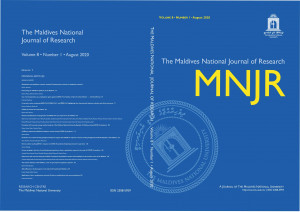Assessment of trans-fats in the Maldivian diet
DOI:
https://doi.org/10.62338/82cv7h26Keywords:
Trans-fats, Maldives, frequency of consumption, TFA level, Maldivian dietAbstract
Consumption of trans-fatty acids (TFA), which are unsaturated fatty acids, are associated with increased risk of non-communicable diseases. The aim of this study was to assess the trans-fat content in foods consumed by the Maldivian population and their frequency of consumption of fatty foods likely to contain TFA. The methodology consists of a cross-sectional survey of 600 participants. A screening questionnaire was used to measure/assess the frequency of consumptions of foods containing trans-fats. The results showed that the frequency of consumption of foods containing trans-fats/trans-fatty acids were low among the study participants. Some participants reported that they consume locally-made foods or imported foods which contain trans-fats. Since the Maldives do not have legislations to ban trans-fats from food supplies, the country may be vulnerable to importing foods containing high trans-fats. Therefore, the Maldives may need to consider developing policies on TFA content in oils and foods.
References
Angell, S. Y., Silver, L. L., Goldstein, G. P., Johnson, C. C., Deitcher, D. B., Frieden, T. R., & Bassett, M. T. (2009). Cholesterol Control Beyond the Clinic: New York City’s Trans-Fat Restriction. Annals of Internal Medicine, 151(2), 129. https://doi.org/10.7326/0003-4819-151-2-200907210-00010
United Nations Decade of Action on Nutrition (2016-2025): resolution /: adopted by the General Assembly. (2016, April 1). United Nations Digital Library System. https://digitallibrary.un.org/record/827756?ln=en
Bhat, S., Maganja, D., Huang, L., Wu, J. H. Y., & Marklund, M. (2022). Influence of heating during cooking on trans-fatty acid content of edible oils: A Systematic Review and Meta-Analysis. Nutrients, 14(7), 1489. https://doi.org/10.3390/nu14071489
Bhardwaj, S., Passi, S. J., Misra, A., Pant, K. K., Anwar, K., Pandey, R. M., & Kardam, V. (2016). Effect of heating/reheating of fats/oils, as used by Asian Indians, on trans-fatty acid formation. Food Chemistry, 212, 663–670. https://doi.org/10.1016/j.foodchem.2016.06.021
Chavasit, V., Photi, J., Kriengsinyos, W., Ditmetharoj, M., Preecha, S., & Tontisirin, K. (2019). Overcoming the trans-fat problem in Thailand. Current Developments in Nutrition, 3(6), nzz045. https://doi.org/10.1093/cdn/nzz045
Dobarganes, C., & Márquez-Ruiz, G. (2015). Possible adverse effects of frying with vegetable oils. British Journal of Nutrition, 113(S2), S49–S57. https://doi.org/10.1017/s0007114514002347
Downs, S. M., Thow, A. M., & Leeder, S. R. (2013). The effectiveness of policies for reducing dietary trans-fat: a systematic review of the evidence. Bulletin of the World Health Organization, 91(4), 262-269H. https://doi.org/10.2471/blt.12.111468
Gupta, V., Downs, S. M., Ghosh-Jerath, S., Lock, K., & Singh, A. (2016). Unhealthy fat in street and snack foods in low-socioeconomic settings in India: A case study of the food environments of rural villages and an urban slum. Journal of Nutrition Education and Behavior, 48(4), 269-279.e1. https://doi.org/10.1016/j.jneb.2015.11.006
Leth, T., Jensen, H. J., Mikkelsen, A. Æ., & Bysted, A. (2006). The effect of the regulation on trans-fatty acid content in Danish food. Atherosclerosis Supplements, 7(2), 53–56. https://doi.org/10.1016/j.atherosclerosissup.2006.04.019
Lichtenstein, A. H. (2014). Dietary trans-fatty acids and cardiovascular disease risk: past and present. Current Atherosclerosis Reports, 16(8). https://doi.org/10.1007/s11883-014-0433-1
Micha, R., Khatibzadeh, S., Shi, P., Fahimi, S., Lim, S. S., Andrews, K. G., Engell, R. E., Powles, J., Ezzati, M., & Mozaffarian, D. (2014). Global, regional, and national consumption levels of dietary fats and oils in 1990 and 2010: a systematic analysis including 266 country-specific nutrition surveys. BMJ, 348(apr14 18), g2272. https://doi.org/10.1136/bmj.g2272
Ministry of Health of The Republic of Lithuania (2011). On the approval of the description of the procedure for catering organization in pre-school education, Lithuania, Ministry of Health.
Moreno, M. C. M. M., Olivares, D. M., Lopez, F. J. A., Adelantado, J. V. G. & Reig, F. B. (1999). Analytical evaluation of polyunsaturated fatty acids degradation during thermal oxidation of edible oils by Fourier transform infrared spectroscopy. Talanta, 50(2), 269–275. https://doi.org/10.1016/s0039-9140(99)00034-x
Mozaffarian, D., Aro, A. R., & Willett, W. C. (2009). Health effects of trans-fatty acids: experimental and observational evidence. European Journal of Clinical Nutrition, 63(S2), S5–S21. https://doi.org/10.1038/sj.ejcn.1602973
Naila, A., Raheem, R. A. & Ismail, A. S. (2022). Fatty acid composition in local and international food products available in the Maldives. Current Nutrition & Food Science, 18, 82-89.
Nishida, C. & Uauy, R. (2009). Update on health consequences of trans-fatty acids: Introduction. European Journal of Clinical Nutrition, 63(S2), S1–S4. https://doi.org/10.1038/ejcn.2009.13
Przybylski, R. & Aladedunye, F. A. (2012). Formation of trans-fats: during food preparation. Canadian Journal of Dietetic Practice and Research, 73(2), 98–101. https://doi.org/10.3148/73.2.2012.98
Stender, S., Astrup, A. & Dyerberg, J. (2016). Artificial trans-fat in popular foods in 2012 and in 2014: a market basket investigation in six European countries. BMJ Open, 6(3), e010673. https://doi.org/10.1136/bmjopen-2015-010673
Tarrago-Trani, M. T., Phillips, K. M., Lemar, L. E. & Holden, J. M. (2006). New and existing oils and fats used in products with reduced trans-fatty acid content. Journal of the American Dietetic Association, 106(6), 867–880. https://doi.org/10.1016/j.jada.2006.03.010
Tarar, O. M., Ahmed, K. A., Nishtar, N. A., Achakzai, A. K. K., Gulzar, Y., Delles, C., & Al-Jawaldeh, A. (2020). Understanding the complexities of prevalence of trans-fat and its control in food supply in Pakistan. Journal of Clinical Hypertension, 22(8), 1338–1346. https://doi.org/10.1111/jch.13943
Wanders, A. J., Zock, P. L. & Brouwer, I. A. (2017). Trans-fat intake and its dietary sources in general populations worldwide: A systematic review. Nutrients, 9(8), 840. https://doi.org/10.3390/nu9080840
WHO (2018a) An action package to: Eliminate industrially-produced trans-fatty acids.In https://www.who.int/ (WHO/NMH/NHD/18.4). Retrieved May 11, 2023, from https://www.who.int/docs/default-source/documents/replace-transfats/replace-action-package.pdfAssessment of trans-fat in the Maldivian diet
WHO. (2018b). Saturated fatty acid and trans-fatty acid intake for adults and children.https://cdn.who.int. Retrieved May 11, 2023, from https://cdn.who.int/media/docs/default-source/nutritionlibrary/cfs-vgfsyn/draft-who-sfa-tfa-guidelines-public-consultation.pdf?sfvrsn=dc29c6af_5
WHO. (2018c). REPLACE trans-fat: frequently asked questions. In WHO (WHO/NMH/NHD/18.7). Retrieved May 11, 2023, from https://www.who.int/publications/i/item/WHO-NMH-NHD-18.7



